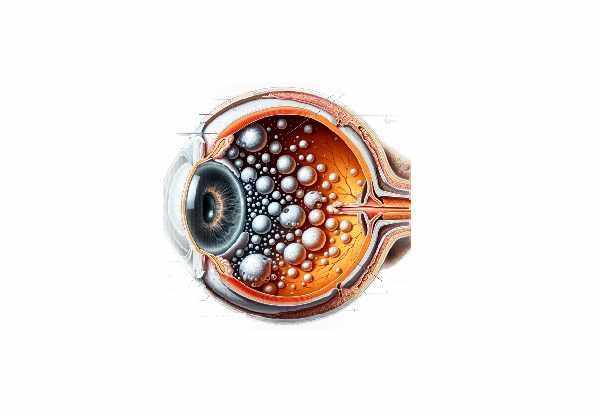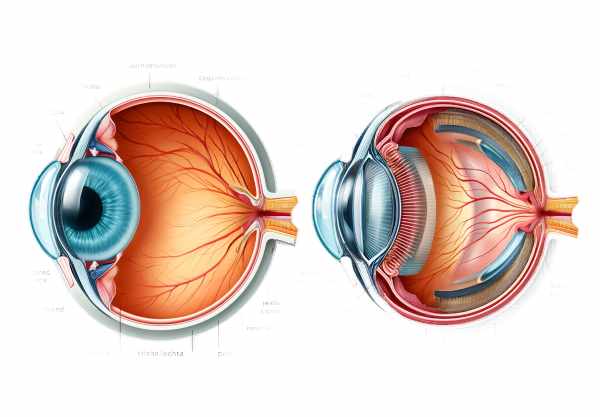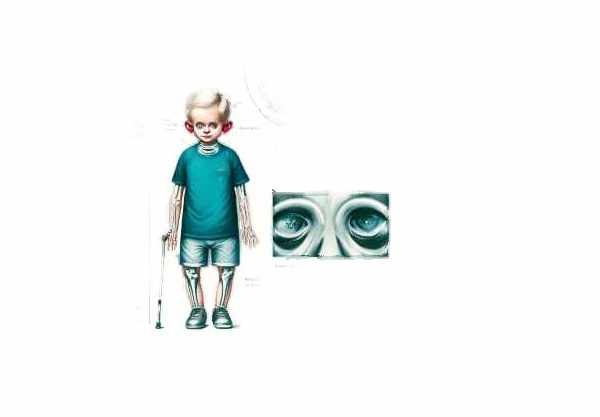Astigmatism: Key Facts and Information
What is Astigmatism? Astigmatism is a common refractive error in the eye that results in blurred or distorted vision at any distance. It occurs when the cornea or lens has an irregular shape, resulting in multiple focal points in the eye instead of a single clear focal point on the retina. This condition can affect both children and adults and...
Asteroid Hyalosis: Key Facts and Information
What is Asteroid Hyalosis? Asteroid hyalosis is an ocular condition marked by the presence of small, white opacities known as "asteroid bodies" in the vitreous humor of the eye. These opacities are made up of calcium-lipid complexes and are usually asymptomatic, discovered by chance during routine eye exams. Despite its innocuous nature, asteroid hyalosis can occasionally interfere with ophthalmic exams...
Arteritic anterior ischemic optic neuropathy (AAION)
Introduction Arteritic anterior ischemic optic neuropathy (AAION) is a serious ocular condition marked by sudden vision loss caused by inflammation and occlusion of the arteries that supply blood to the optic nerve head. It is most commonly associated with giant cell arteritis (GCA), an inflammatory disease of the blood vessels that primarily affects older people. Awareness and early detection of...
Aphakia: Key Facts and Management Solutions
What is Aphakia? Aphakia is an ocular condition defined by the absence of the natural lens in the eye. This condition may be caused by surgical removal, trauma, or congenital defects. The lens is necessary for focusing light onto the retina to produce clear images, and its absence can result in significant vision impairment. Early detection and management of aphakia...
Anterior uveitis
What is Anterior Uveitis? Anterior uveitis, also known as iritis, is an inflammation of the uvea, which includes the iris and anterior chamber of the eye. This is the most common type of uveitis and can affect people of any age. Anterior uveitis can cause severe discomfort and visual disturbances, such as eye pain, redness, blurred vision, and light sensitivity....
Anterior Subcapsular Cataract: Symptoms and Solutions
What is the Anterior Subcapsular Cataract? An anterior subcapsular cataract is a type of cataract that develops in the front of the lens, just below the lens capsule. This condition can severely impair vision, resulting in symptoms like blurred vision, glare, and difficulty seeing in bright light. Unlike other types of cataracts that usually develop with age, anterior subcapsular cataracts...
Managing Anophthalmia and Microphthalmia Effectively
introduction Anophthalmia and microphthalmia are rare congenital eye disorders that cause the absence or underdevelopment of one or both eyes. Anophthalmia is defined as the complete absence of ocular tissue, whereas microphthalmia denotes an abnormally small eye. Both conditions can occur independently or as part of a syndrome that includes other systemic abnormalities. Early detection and awareness are critical for...
Anisometropia.
Introduction to Anisometropia Anisometropia is a common ocular condition that causes a significant difference in refractive power between the two eyes. This difference can result in unequal focus, causing one eye to be more nearsighted, farsighted, or astigmatic than the other. If left untreated, anisometropia can cause amblyopia (lazy eye) and other visual problems. Early detection and treatment are critical...
Anisocoria.
What is Anisocoria? Anisocoria is a condition defined by unequal pupil sizes in the eyes. It is a fairly common finding that can be physiological (normal) or pathological (indicating an underlying condition). The pupils, which control the amount of light entering the eyes, are usually the same size and respond similarly to light. However, in cases of anisocoria, one pupil...
Aniridia: Key Facts and Information
What is Aniridia? Aniridia is a rare congenital eye condition marked by the partial or complete absence of the iris, the colored part of the eye that regulates the amount of light that enters the eye. This condition is usually present from birth and affects both eyes. Aniridia can cause a variety of visual impairments and is frequently associated with...
Amblyopia: Key Facts and Solutions
What is Amblyopia? Amblyopia, also known as "lazy eye," is a visual development disorder in which one eye does not achieve normal visual acuity, even with prescription glasses or contact lenses. It usually begins during infancy or early childhood. Early detection and treatment are critical because if left untreated, amblyopia can cause permanent vision impairment. Awareness of this condition is...
Albinism (Ocular and Oculocutaneous).
Introduction to Albinism Albinism is a genetic condition defined by a lack of melanin pigment in the skin, hair, and eyes. This condition affects people worldwide, regardless of race or ethnicity, and is divided into two types: ocular albinism, which primarily affects the eyes, and oculocutaneous albinism, which affects the eyes, skin, and hair. Awareness and early detection of albinism...
Age-related macular degeneration (AMD).
What is age-related macular degeneration (AMD)? Age-related macular degeneration (AMD) is a common eye condition that primarily affects people over the age of 50. This degenerative disease affects the macula, the central portion of the retina that is responsible for the sharp and central vision required for tasks such as reading, driving, and recognizing faces. As AMD progresses, it can...
Adie’s Pupil: Key Facts and Tips
What Is Adie's pupil? Adie's pupil, also known as tonic pupil, is a neurological condition in which the eye's pupil reacts abnormally to light. This condition usually manifests as a unilateral, enlarged pupil that reacts slowly to direct light but constricts more quickly during near vision tasks, a phenomenon known as light-near dissociation. While Adie's pupil is typically benign, it...
Comprehensive Guide to Ocular Actinic Keratosis
What is Ocular Actinic Keratosis? Ocular actinic keratosis is a rare but serious eye condition caused by prolonged exposure to ultraviolet (UV) radiation. While actinic keratosis is most commonly associated with the skin, resulting in rough, scaly patches in sun-exposed areas, its ocular variant causes similar changes in the tissues of the eye, specifically the conjunctiva. This condition primarily affects...
Eye condition: “Acrochordon (skin tags)”
Introduction to Acrochordon Acrochordon, also known as skin tags, is a benign condition marked by small, soft, flesh-colored growths that appear in areas where the skin creases. Although not harmful, these growths can be a cosmetic concern and occasionally cause discomfort or irritation, especially in sensitive areas like the eyes. Awareness and early detection of acrochordons are critical for effective...
Achromatopsia: Causes, Symptoms, and Management
What is Achromatopsia? Achromatopsia, also known as total color blindness, is a rare hereditary eye condition marked by a complete inability to perceive color. Individuals with achromatopsia perceive the world in black, white, and gray. Other visual impairments commonly associated with this condition include light sensitivity (photophobia), reduced visual acuity, and involuntary eye movements (nystagmus). Awareness and early detection of...
Achondroplasia: Orbital Development and Vision Impact
Introduction to Achondroplasia Achondroplasia is a genetic disorder that causes dwarfism, defined by short stature and disproportionately short limbs. This condition is caused by mutations in the FGFR3 gene, which have a significant impact on bone growth. While the primary manifestations of achondroplasia are skeletal abnormalities, it also affects the development of craniofacial structures such as the orbits. Awareness of...
Acanthamoeba Keratitis.
What is Acanthamoeba Keratitis? Acanthamoeba keratitis is a rare but serious eye infection caused by the free-living amoeba Acanthamoeba, which can be found in various water sources, soil, and air. This infection primarily affects the cornea, the clear, dome-shaped surface that protects the front of the eye. If not treated promptly, the condition can cause severe pain, vision loss, and,...
Eye Health Benefits of Tomatoes
Introduction to Tomatoes Tomatoes, scientifically known as Solanum lycopersicum, are one of the most popular and versatile fruits worldwide. Tomatoes were originally native to western South America before being domesticated in Mexico and spreading around the world following Spanish colonization of the Americas. Tomatoes are now a common ingredient in many cuisines, celebrated for their rich flavor and nutritional value. Tomatoes...
Eye Health Benefits of Swiss Chard
What is Swiss Chard? Swiss chard, scientifically known as Beta vulgaris subsp. cicla, is a leafy green vegetable from the same family as beets and spinach. Swiss chard, which originated in the Mediterranean region, has been a staple of many cultures' diets for centuries. It is known not only for its bright colors, which range from deep green leaves to...
Eye Health Benefits of Sweet Potatoes
Introduction to Sweet Potato. Sweet potatoes, scientifically known as Ipomoea batatas, are starchy root vegetables that are both delicious and nutritious. Sweet potatoes were first cultivated in Central and South America thousands of years ago. They come in a variety of colors, including orange, purple, and white, and each has a distinct flavor and nutritional profile. Orange-fleshed varieties are especially...
Boost Your Vision with Strawberries
Introduction to Strawberries Strawberries (Fragaria × ananassa) are one of the most popular and widely consumed fruits globally. Strawberries are believed to have originated in Europe in the 18th century through the hybridization of wild strawberry species from the Americas and Europe. These bright red, juicy berries are known for their delicious flavor and aroma, making them popular in desserts,...
Eye Health Benefits of Eating Spinach
Introduction to Spinach Spinach is a leafy green vegetable from the Amaranthaceae family that originated in Persia (modern-day Iran) but has since become a staple in cuisines around the world. Its cultivation dates back to antiquity, and it is well-known for its diverse culinary applications and impressive health benefits. Spinach is well-known for its vibrant green color and mild flavor,...

























